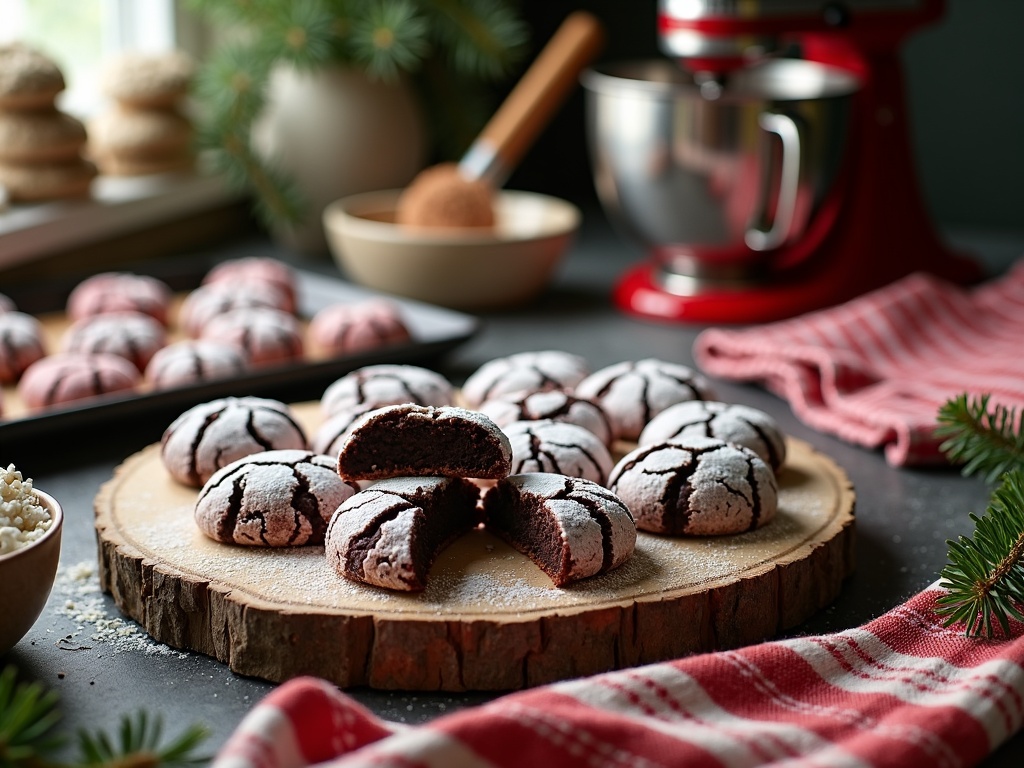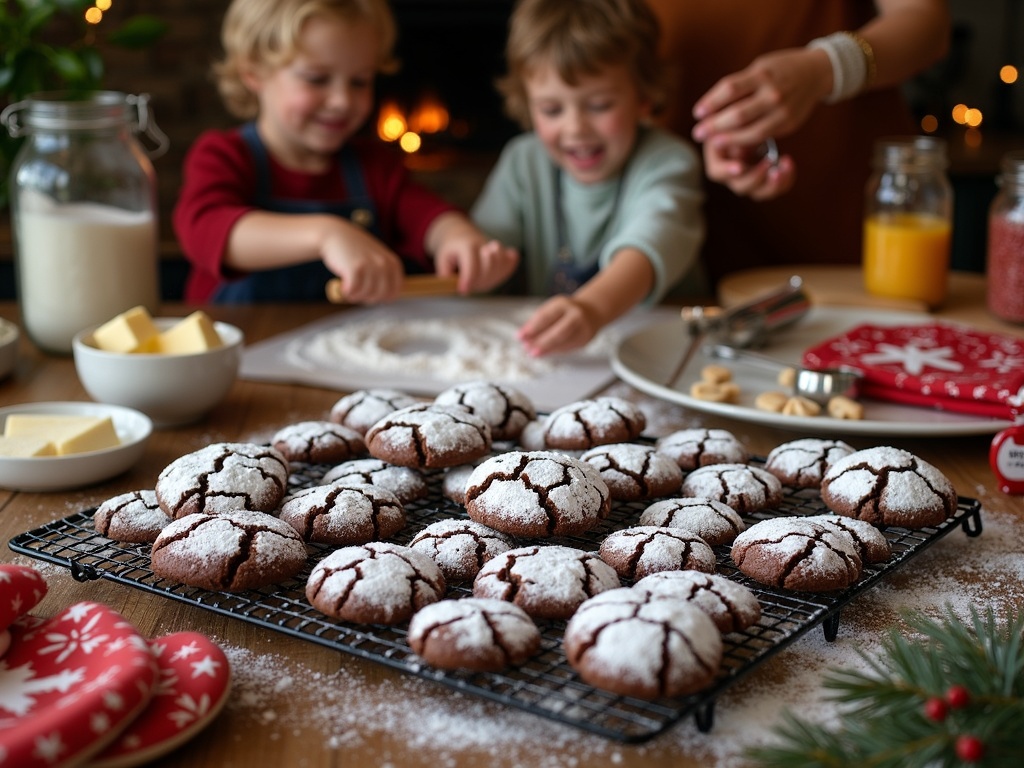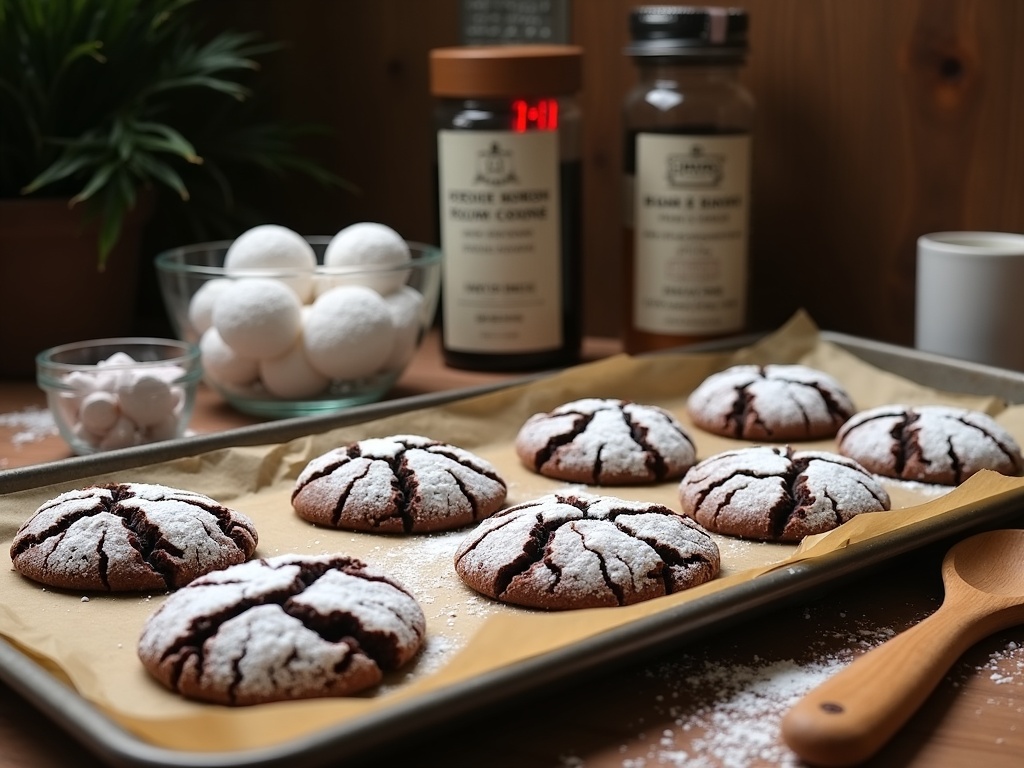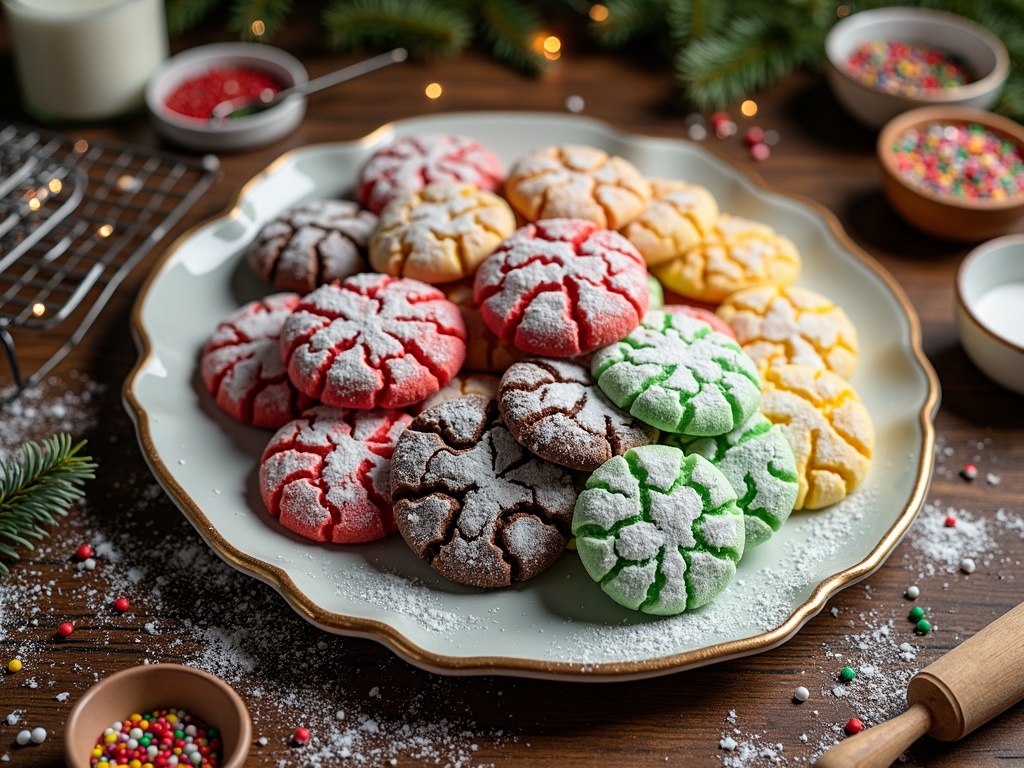Crinkle cookies draw in dessert lovers with their unique look – deep, fudgy chocolate centers showing through cracked powdered sugar coatings. They strike the perfect balance with crisp edges and chewy middles, creating an eye-catching treat that’s easy to make regardless of your baking experience.
Table of Contents
Key Takeaways
- The signature cracked appearance forms when cookies expand during baking, creating breaks in the powdered sugar coating that reveal the dark cookie underneath.
- Chilling the dough is essential for proper texture and pronounced crinkles, with overnight refrigeration producing the best results.
- The contrast between the soft interior and slightly crisp exterior creates a textural experience that makes these cookies uniquely satisfying.
- While chocolate is traditional, variations like red velvet, lemon, mint, and peanut butter offer creative alternatives with the same characteristic crackled appearance.
- Proper storage techniques can extend freshness for up to 5 days at room temperature, or the dough can be frozen for up to 3 months for on-demand baking.
Why These Sweet Treats Are So Beloved
Crinkle cookies have captured the hearts of dessert enthusiasts everywhere with their distinctive appearance and irresistible texture. The magic of these treats lies in their perfect contrast – a rich, fudgy chocolate interior hidden beneath a crackled powdered sugar coating that creates their iconic appearance. I’ve found that these cookies strike a rare balance that few other desserts achieve, making them a staple at holiday gatherings and cookie exchanges.
The Perfect Texture Combination
The textural experience of biting into a well-made crinkle cookie is truly something special. The exterior offers a slight crisp from the baked sugar coating, while the interior remains remarkably soft and chewy. This duality happens because the outside of the cookie bakes faster than the center, creating that perfect contrast that cookie lovers crave.
This specific texture profile comes from the careful balance of ingredients. The density of the chocolate base provides that fudgy center that makes these cookies so craveable. For those curious about what creates this perfect density in cookies, understanding the role of certain ingredients that make cookies dense can help you master not just crinkles but other cookie varieties too.
The visual appeal of crinkle cookies is just as important as their taste. As the cookies bake, the dough expands, creating those distinctive cracks in the powdered sugar coating. This natural pattern makes each cookie unique – like tiny edible snowflakes. Their dramatic, contrasting colors of dark chocolate peeking through bright white powdered sugar create an eye-catching addition to any cookie platter.
A Holiday Tradition Made Accessible
Crinkle cookies have secured their place as a holiday tradition for many families. Their snow-topped appearance makes them particularly fitting for winter celebrations, but their appeal extends throughout the year. I’ve discovered that while they look fancy and complicated, crinkle cookies are surprisingly achievable for bakers of all experience levels.
The basic chocolate crinkle is just the beginning. Creative bakers have expanded the crinkle cookie universe with variations including:
- Red velvet crinkles with their vibrant color and subtle cocoa flavor
- Lemon crinkles that offer a bright, citrusy alternative to the classic chocolate
- Mint chocolate versions that add a refreshing twist to the traditional recipe
- Peanut butter crinkles for those who love that classic flavor combination
Many bakers are now experimenting with colorful ingredients in their cookie recipes, taking crinkle cookies beyond their traditional chocolate roots. The versatility of the crinkle method allows for creative expression while maintaining that beloved crackled exterior.
For those looking to create bakery-quality cookies at home, the crinkle cookie offers tremendous rewards for relatively little effort. Unlike some commercial cookie recipes that can be challenging to replicate, these treats don’t require specialized equipment or techniques. Their impressive appearance comes naturally from the baking process, not from complicated decorating skills.
Fans of popular cookie brands will find similarities between chocolate crinkle cookies and some commercial favorites. Those who enjoy the rich chocolate flavors of Crumbl’s chocolate cookies might be surprised at how easily they can create something equally delicious at home with a good crinkle cookie recipe.
The enduring popularity of crinkle cookies speaks to their universal appeal. They satisfy chocolate cravings with their intense flavor while offering that textural complexity that keeps you coming back for just one more. Whether you’re an experienced baker or just starting out, these cookies deliver a sense of accomplishment along with their delicious taste – creating the perfect sweet treat that’s as fun to make as it is to eat.

What Makes These Cookies Special
Crinkle cookies stand out in the cookie world with their distinct crackled surface and fudgy interior. I find these treats irresistible for their visual appeal and the perfect contrast between the crisp exterior and soft center. They’ve become a staple in my holiday baking rotation, but they’re versatile enough to enjoy year-round.
Distinctive Appearance and Texture
The signature crackled appearance of crinkle cookies comes from a clever technique of rolling dough balls in powdered sugar before baking. As the cookies spread and rise in the oven, the dough breaks through the sugar coating, creating those characteristic cracks across the surface. This method produces a stunning contrast between the dark cookie and bright white powdered sugar “crinkles” that makes them instantly recognizable on any cookie platter.
What truly sets these cookies apart is their brownie-like interior texture. While the outside offers a slight crispness, the inside remains wonderfully soft and fudgy. This textural contrast makes each bite a delightful experience, similar to freshly baked Crumbl cookies that balance crunchy edges with tender centers. The density of the cookie depends on several factors, including the proportion of ingredients that create density like flour and fats.
Practical Benefits for Bakers
Crinkle cookies offer several practical advantages that make them a go-to recipe in my kitchen:
- Make-ahead friendly: The dough can be prepared up to 3 days ahead and refrigerated.
- Freezer-ready: Both unbaked dough balls and baked cookies freeze beautifully for up to 3 months.
- Portion control: Using a cookie scoop ensures uniform size for consistent baking.
- No cookie cutter needed: Simply roll into balls, saving time and cleanup.
- Long shelf life: They stay fresh in an airtight container for several days.
I’ve found that these cookies actually improve with a bit of rest time. The flavors meld together when the dough chills overnight, producing an even more complex and satisfying treat. This makes them ideal for planning ahead when entertaining or preparing for holiday cookie exchanges.
Beyond their delicious taste, crinkle cookies make for a fantastic baking project with kids. Children love rolling the sticky dough balls in powdered sugar and watching the magical transformation in the oven as the cracks appear. The process provides several kid-friendly steps:
- Measuring ingredients and mixing the dough
- Rolling dough into balls with their hands
- Coating the balls in powdered sugar
- Checking on the cookies as they bake and spread
- Watching the crackle pattern develop
The visual process of creating these cookies is half the fun, with colorful variations possible depending on your flavor preferences. While chocolate remains the classic choice, I’ve experimented with red velvet, lemon, matcha, and pumpkin versions—all maintaining that distinctive crackled appearance while offering different flavor profiles.
The versatility of crinkle cookies extends to their ability to adapt to different dietary needs. I’ve successfully created gluten-free and dairy-free versions by substituting appropriate ingredients without sacrificing that characteristic texture and appearance.
Whether you’re looking for a showstopper cookie with minimal effort or a fun baking activity that yields delicious results, crinkle cookies deliver on all fronts. Their unique combination of visual appeal, delightful texture, and practical conveniences makes them truly special in the wide world of cookies.

Everything You’ll Need
Crinkle cookies are iconic for their distinctive cracked appearance and fudgy interior. I’ve found that gathering all ingredients before starting makes the baking process much smoother. Let’s break down what you’ll need to create these delightful treats.
Dry Ingredients
The foundation of any good crinkle cookie starts with quality dry ingredients that provide structure and flavor:
- All-purpose flour: 1 cup serves as the base structure for your cookies
- Cocoa powder: ½ cup gives that rich chocolate flavor (use Dutch-processed for a deeper color)
- Baking powder: 1 teaspoon helps the cookies rise and create those signature cracks
- Salt: ½ teaspoon balances the sweetness and enhances flavor
The cocoa powder is particularly important as it gives crinkle cookies their distinct chocolate flavor. For the best results, I recommend using high-quality cocoa powder that hasn’t been sitting in your pantry for years. The difference in taste between fresh and old cocoa powder is remarkable in chocolate cookie recipes with distinctive ingredients.
Wet Ingredients and Coating
These ingredients bring moisture, sweetness, and the characteristic crinkle appearance:
- Large eggs: 2 eggs bind everything together and add structure
- Granulated sugar: ¾ cup provides sweetness and helps create the crisp exterior
- Vegetable oil: ½ cup makes the cookies moist and fudgy (can substitute with melted butter for a different flavor profile)
- Vanilla extract: 1 teaspoon adds depth of flavor
- Powdered sugar: About 1 cup for coating, creating that beautiful snow-capped appearance
The vegetable oil might seem like an unusual choice if you’re used to making butter-based cookies like Crumbl-style treats, but it’s key to creating the soft, brownie-like interior that makes crinkle cookies so craveable.
Coating the cookie dough balls in powdered sugar before baking is crucial. As the cookies bake and spread, cracks form in the sugar coating, revealing the dark chocolate beneath. This contrast creates the striking crinkle pattern these cookies are named for.
I’ve found that chilling the dough makes a significant difference in how well the powdered sugar sticks and how pronounced the crinkles become. Cold dough spreads more slowly in the oven, giving time for the exterior to set while the inside continues to rise, forming deeper cracks.
The quality of your ingredients will impact the final result. Fresh baking powder is essential—if it’s been sitting in your pantry for over six months, consider replacing it. Cookies made with expired baking powder won’t rise properly, resulting in flat cookies with minimal crinkle effect.
For a denser, fudgier texture in your crinkle cookies, you can adjust the flour-to-cocoa ratio. More cocoa and less flour will create a denser cookie with intense chocolate flavor, similar to a brownie.
While the classic recipe calls for vanilla extract, you can experiment with other extracts like peppermint during the holidays or almond for a subtle nutty flavor. Just keep the amounts the same to maintain the proper wet-to-dry ingredient ratio.
Measuring your ingredients accurately is vital for consistent results. I suggest using the spoon-and-level method for flour and cocoa powder rather than scooping directly from the container, which can pack too much into your measuring cup and result in dry cookies.
Step-by-Step Baking Guide
Creating perfect crinkle cookies requires attention to detail and proper technique. I’ve perfected this process over years of baking and can guide you through each crucial step to achieve those distinctive cracks and fudgy centers.
Creating Your Cookie Dough
First, mix your dry ingredients thoroughly in a large bowl. Proper incorporation of flour, cocoa powder, baking powder, and salt ensures even flavor distribution and consistent texture. For truly standout cookies, sift the dry ingredients to remove any lumps, especially in the cocoa powder.
Next, beat your wet ingredients separately until creamy and light. This typically includes butter, sugar, eggs, and vanilla extract. The creaming process incorporates air into the mixture, which helps create that perfect crinkle cookie texture.
When combining the wet and dry mixtures, fold them together gradually until smooth. Be careful not to overmix, as this can develop too much gluten and result in tough cookies instead of the tender, dense texture that makes crinkle cookies so delightful.
After achieving a consistent dough, chilling is absolutely essential. The dough needs at least 4 hours in the refrigerator, though overnight works even better. This resting period allows flavors to meld and the fats to solidify, preventing excessive spreading during baking.
Once chilled, shape the dough into uniform balls—about 1-inch diameter works well. For best results, use a small cookie scoop to ensure consistent sizing, which leads to even baking.
The signature step in creating crinkle cookies comes next: rolling each ball in powdered sugar. Apply a generous coating for maximum visual impact. The contrast between the dark cookie and white powdered sugar creates that classic crackled appearance.
Finally, bake the cookies until they’ve spread and developed their characteristic cracked surface. The cookies will appear slightly underdone in the center when you remove them from the oven—this ensures they’ll have the perfect fudgy interior once cooled.
For an interesting variation, consider adding colorful ingredients like mint chips or orange zest to create unique flavor profiles while maintaining the classic crinkle appearance.
Common Mistakes to Watch For
Making crinkle cookies might seem straightforward, but certain missteps can turn these delightful treats into disappointments. I’ve identified four key errors that home bakers frequently make when preparing these distinctive powdered sugar-coated cookies.
Critical Errors That Affect Your Crinkle Cookies
Skipping the chilling time is perhaps the most common mistake I see new bakers make. When you rush this crucial step, your dough spreads too quickly in the oven, resulting in flat cookies without those characteristic deep cracks. The chilling process allows the fats to solidify, which controls the spread rate during baking. For optimal results, I recommend at least 2-4 hours of refrigeration, though overnight chilling produces even better texture and flavor development. This patience pays off with perfectly cracked tops that give crinkle cookies their distinctive appearance similar to other popular cookie varieties.
Using old baking powder is another frequent error that affects your cookie’s rise and texture. Baking powder loses its potency over time, especially when exposed to air or moisture. When your leavening agent isn’t fresh, cookies won’t rise properly, leading to dense, flat results without those iconic cracks. I suggest replacing your baking powder every six months and testing it by putting a teaspoon in hot water – if it bubbles vigorously, it’s still active. The quality of your ingredients, including baking powder, plays a significant role in determining what makes your cookies dense or light in the final product.
Not coating the dough thoroughly in powdered sugar creates another disappointing outcome. These cookies get their striking appearance from the contrast between the dark cookie and bright white sugar coating. When the coverage is thin or uneven, you lose that visual impact. I’ve found that rolling the chilled dough balls in granulated sugar first, then generously in powdered sugar, creates the best coating. This double-coating technique helps the powdered sugar adhere better and prevents it from being completely absorbed during baking, maintaining those dramatic white patterns against the colorful cookie base.
Overbaking is the final pitfall that can ruin even perfectly prepared crinkle cookie dough. These cookies should maintain a slightly soft center when removed from the oven, as they’ll continue cooking on the hot baking sheet. When left too long in the oven, they become dry and hard rather than maintaining their ideal chewy texture. I recommend removing them when the edges are set but the centers still appear slightly underbaked. For chocolate crinkle cookies, this can be hard to judge visually, so timing is essential – usually 10-12 minutes at 350°F is perfect for standard-sized cookies.
Here are some telltale signs your crinkle cookies have gone wrong:
- Cookies that spread too thin and have minimal cracking (insufficient chilling)
- Flat, dense cookies with minimal rise (old baking powder)
- Cookies where the powdered sugar has completely disappeared (insufficient coating)
- Dry, hard cookies that lack the signature chewy center (overbaking)
By avoiding these common mistakes, I’ve found that even novice bakers can achieve picture-perfect crinkle cookies with impressive visual appeal and that ideal balance of crisp exterior and chewy interior. The key lies in respecting the process – particularly the chilling time – and using fresh, quality ingredients coated properly and baked just to the point of perfection.

Pro Tips for Perfect Results
Making crinkle cookies might seem straightforward, but a few expert techniques can elevate them from good to spectacular. I’ve gathered some professional insights that will help you achieve those picture-perfect cracks and delicious flavor every time.
Essential Techniques for Success
Fresh ingredients make all the difference when baking crinkle cookies. Always check your baking powder and baking soda dates – these leavening agents lose potency over time and can prevent proper rising and cracking. Fresh eggs and butter also contribute significantly to the texture and taste of your cookies.
The secret weapon in creating those beautiful cracks is patience. Chilling the dough overnight allows the flavors to develop and the fats to solidify. This crucial step prevents excessive spreading during baking and creates that sought-after dense, fudgy center that makes crinkle cookies so irresistible.
Consistency matters tremendously in baking. I recommend using a cookie scoop or measuring tablespoon to ensure all your cookie dough balls are the same size. This uniformity guarantees even baking and a professional-looking batch. Roll the chilled dough between your palms to create smooth balls that will crack evenly.
Don’t give in to the temptation to flatten your cookies before baking! Unlike other cookie varieties, crinkle cookies should be placed on the baking sheet as rolled balls. This shape allows them to rise and fall naturally during baking, creating those distinctive cracks across the surface.
Patience plays another important role after baking. Let your crinkle cookies cool completely on the baking sheet before attempting to move them. They’ll continue cooking slightly from residual heat and will firm up as they cool. Moving them too early can cause them to break or lose their chewy texture.
For extra visual appeal, consider incorporating colorful ingredients into your crinkle cookies. Red velvet crinkles or cookies made with natural food colors can create stunning results for holidays or special occasions.
I find that coating the dough balls generously in powdered sugar – not just a light dusting – creates the most dramatic crinkled effect. Don’t be shy with that powdered sugar coating; it should be thick enough that you can barely see the dough underneath.
Storage and Make-Ahead Options
Properly storing crinkle cookies ensures they maintain their delightful texture and flavor. I’ve found that with the right storage techniques, you can enjoy these treats for days or even months after baking.
Keeping Your Crinkle Cookies Fresh
Storing crinkle cookies in an airtight container at room temperature is the most straightforward option. They’ll stay fresh for up to 5 days this way, though the texture will be at its peak during the first 3 days. To prevent cookies from sticking together, place a sheet of parchment paper between layers. This simple step is especially important for crinkle cookies since their powdered sugar coating can become tacky over time.
For longer storage, freezing is your best bet. Baked crinkle cookies freeze beautifully for up to 3 months without sacrificing quality. To freeze them properly:
- Allow cookies to cool completely
- Place in a single layer on a baking sheet to flash freeze for 1 hour
- Transfer to freezer bags or containers, adding parchment between layers
- Remove as much air as possible before sealing
- Label with the date and cookie type
When you’re ready to enjoy them, thaw the cookies at room temperature for about 30–60 minutes. The texture may be slightly different from fresh-baked, but a quick 5–10 second warm-up in the microwave can restore some of that just-baked quality.
If you prefer having fresh-baked cookies on demand, freezing the dough is an excellent option. Form your dough into balls but hold off on the sugar coating. This approach gives you the flexibility to bake cookies fresh whenever the craving strikes. The frozen dough balls should be:
- Placed on a parchment-lined baking sheet
- Frozen until solid (about 1–2 hours)
- Transferred to freezer containers or bags
- Labeled with date and baking instructions
To bake from frozen, thaw the dough balls overnight in the refrigerator. Once thawed, roll them in the powdered sugar coating and bake as directed. You might need to add 1–2 minutes to the baking time. The density of your cookie might change slightly when baking from frozen dough, but the classic crinkle appearance with those characteristic cracks will still develop beautifully.
For a twist on traditional chocolate crinkle cookies, consider using natural color-infusing ingredients like matcha or freeze-dried fruit powder to create festive variations that store just as well as the classic version.
Flavor Variations to Try
Finding the perfect crinkle cookie flavor can transform your baking experience from ordinary to extraordinary. While classic chocolate crinkle cookies remain a staple, exploring different flavor combinations adds excitement to your cookie jar. I’ve experimented with several delicious variations that maintain that signature crackly exterior while surprising your taste buds with every bite.

Exciting Flavor Combinations
Mint chocolate crinkle cookies offer a refreshing twist on the traditional recipe. By adding peppermint extract to your chocolate dough, you create a cooling sensation that pairs beautifully with the rich chocolate base. For an extra festive touch during the holidays, I like to fold in some mint chocolate chips or crushed candy canes before rolling the dough in powdered sugar.
Orange chocolate delivers a sophisticated flavor profile that’s both bright and indulgent. The secret is incorporating fresh orange zest and a splash of orange extract into your chocolate cookie dough. This citrusy variation cuts through the sweetness, creating a balanced cookie that’s perfect with afternoon tea or coffee.
Red velvet crinkle cookies make a stunning addition to any cookie platter with their vibrant color and distinctive flavor. The key to authentic red velvet lies in the combination of cocoa powder, buttermilk, and a hint of vinegar that creates that characteristic tang. The vivid red against the stark white powdered sugar creates a dramatic visual effect that’s sure to impress guests.
Double chocolate chip takes the crinkle cookie experience to new heights of indulgence. Start with a rich chocolate dough, then fold in high-quality chocolate chips or chunks for pockets of melty goodness in every bite. The combination of different chocolate varieties adds depth to these cookies – try mixing dark and milk chocolate chips for a complex flavor profile.
Peanut butter chocolate crinkle cookies combine two classic flavors for an irresistibly nutty treat. The denser texture of peanut butter contributes to a particularly chewy cookie with a satisfying mouthfeel. To achieve the perfect cookie density, I recommend using creamy peanut butter rather than chunky for these crinkles.
Each flavor variation requires small adjustments to the basic crinkle cookie recipe. Here are some tips when adapting your recipe:
- Consider reducing sugar slightly when adding sweet mix-ins like chocolate chips
- Balance moisture levels when incorporating liquid extracts or zest
- Adjust baking time as needed – some variations may bake faster than others
- Allow dough to chill thoroughly before rolling in powdered sugar for the best crinkle effect
- Test a small batch first when experimenting with a new flavor combination
The beauty of crinkle cookies lies in their adaptability while maintaining that signature crackled appearance. The contrast between the dark cookie showing through the white powdered sugar coating creates an eye-catching pattern regardless of which flavor you choose.
For seasonal baking, I rotate through different variations throughout the year. Mint chocolate makes an appearance during winter holidays, orange chocolate brightens spring gatherings, and red velvet adds drama to Valentine’s Day. Double chocolate chip and peanut butter chocolate versions are timeless options that satisfy chocolate cravings year-round.
Keeping the dough consistency right is crucial for achieving those perfect cracks. If your dough becomes too soft while working with it, return it to the refrigerator briefly before continuing to roll and coat the cookies.

